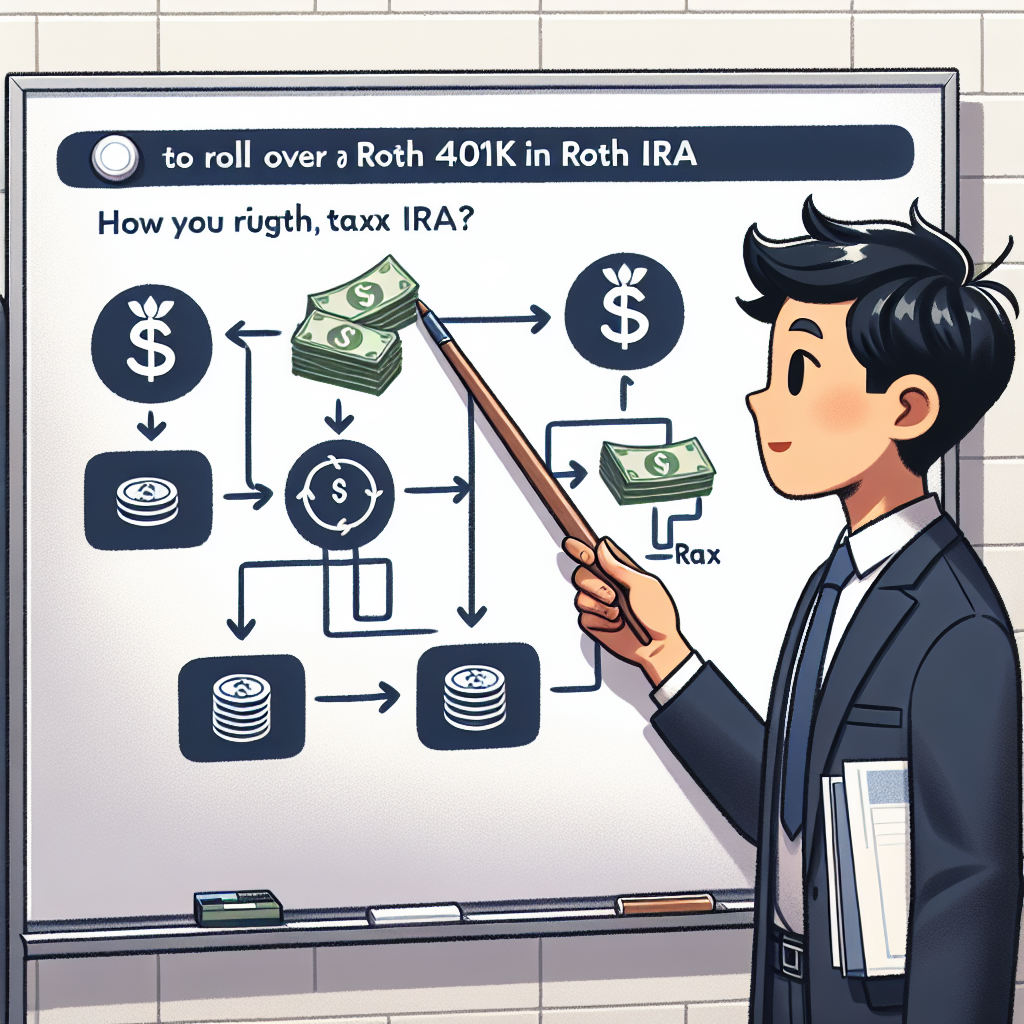“Navigate Your Future: Understanding the Tax Path from Roth 401(k) to Roth IRA.”
Introduction
“Seeking Clarity: Tax Implications of Rolling Over Roth 401(k) to Roth IRA” delves into the nuanced financial landscape that individuals face when considering the transition of retirement funds from a Roth 401(k) to a Roth IRA. This process, while seemingly straightforward, involves a complex interplay of tax regulations and strategic financial planning. The article aims to demystify the tax implications associated with such rollovers, providing a comprehensive guide to understanding potential benefits, pitfalls, and the long-term impact on retirement savings. By exploring key considerations and offering expert insights, it equips readers with the knowledge needed to make informed decisions that align with their financial goals and retirement plans.
Understanding The Basics: Roth 401(k) Vs. Roth IRA
When considering retirement planning, understanding the nuances between different savings vehicles is crucial. Two popular options are the Roth 401(k) and the Roth IRA, each offering unique benefits and tax implications. As individuals approach retirement, they often contemplate rolling over their Roth 401(k) into a Roth IRA. This decision, while seemingly straightforward, requires a thorough understanding of the tax implications involved.
The Roth 401(k) and Roth IRA share a fundamental similarity: both allow for after-tax contributions, meaning that withdrawals during retirement are generally tax-free. However, they differ in terms of contribution limits, required minimum distributions (RMDs), and investment options. The Roth 401(k) is an employer-sponsored plan, often featuring higher contribution limits compared to the Roth IRA. In 2023, for instance, individuals under 50 can contribute up to $22,500 to a Roth 401(k), whereas the Roth IRA limit is $6,500. This distinction can significantly impact one’s savings strategy.
Moreover, Roth 401(k)s are subject to RMDs starting at age 73, a requirement that does not apply to Roth IRAs. This difference is a compelling reason for many to consider rolling over their Roth 401(k) into a Roth IRA, as it allows them to avoid mandatory withdrawals and continue growing their savings tax-free. Additionally, Roth IRAs typically offer a broader range of investment options, providing more flexibility in managing one’s retirement portfolio.
Despite these advantages, the rollover process is not without its complexities. One of the primary concerns is ensuring that the rollover is executed correctly to avoid unintended tax consequences. A direct rollover, where the funds are transferred directly from the Roth 401(k) to the Roth IRA, is generally the most straightforward method. This approach helps prevent any potential tax liabilities that could arise from an indirect rollover, where the account holder receives the funds before depositing them into the Roth IRA.
Another critical consideration is the five-year rule, which applies to both Roth 401(k)s and Roth IRAs. This rule stipulates that for earnings to be withdrawn tax-free, the account must have been open for at least five years. When rolling over a Roth 401(k) to a Roth IRA, it’s essential to understand how this rule applies. If the Roth 401(k) has been open for five years, the rollover does not reset the clock for the Roth IRA. However, if the Roth IRA is new, the five-year period begins from the date of the first contribution to the Roth IRA.
Furthermore, individuals should be aware of potential state tax implications. While federal tax treatment of Roth accounts is consistent, state tax laws can vary significantly. Some states may have specific rules regarding the taxation of rollovers, which could impact the overall tax efficiency of the transaction.
In conclusion, rolling over a Roth 401(k) to a Roth IRA can offer significant benefits, including avoiding RMDs and gaining access to a wider array of investment options. However, it is essential to navigate the process carefully to ensure compliance with tax regulations and maximize the advantages of both accounts. By understanding the differences between these retirement savings vehicles and considering the tax implications, individuals can make informed decisions that align with their long-term financial goals. As always, consulting with a financial advisor or tax professional can provide valuable guidance tailored to one’s specific circumstances.
Tax Implications Of Rolling Over: What You Need To Know
When considering the transition from a Roth 401(k) to a Roth IRA, understanding the tax implications is crucial for making informed financial decisions. Both retirement accounts offer unique benefits, and rolling over funds from a Roth 401(k) to a Roth IRA can be a strategic move for many individuals. However, it is essential to comprehend the tax nuances associated with this rollover to avoid unexpected liabilities and optimize retirement savings.
To begin with, it is important to recognize that both Roth 401(k) and Roth IRA accounts are funded with after-tax dollars. This means that contributions to these accounts are made with income that has already been taxed, allowing for tax-free growth and withdrawals in retirement, provided certain conditions are met. Consequently, when rolling over funds from a Roth 401(k) to a Roth IRA, there are generally no immediate tax consequences. This is because the nature of the funds remains consistent, as both accounts are designed to offer tax-free distributions.
However, there are specific considerations to keep in mind. One of the primary differences between a Roth 401(k) and a Roth IRA is the required minimum distribution (RMD) rules. Roth 401(k) accounts are subject to RMDs starting at age 73, whereas Roth IRAs are not. By rolling over a Roth 401(k) into a Roth IRA, individuals can potentially avoid RMDs, allowing their investments to continue growing tax-free for a longer period. This can be particularly advantageous for those who do not need to access their retirement funds immediately and wish to maximize their tax-free growth potential.
Moreover, it is essential to consider the five-year rule, which applies to Roth IRAs. This rule stipulates that for earnings to be withdrawn tax-free, the Roth IRA must have been open for at least five years. When rolling over a Roth 401(k) to a Roth IRA, the five-year period begins with the first contribution to any Roth IRA, not the date of the rollover. Therefore, if an individual has had a Roth IRA for more than five years, the rollover funds will be immediately eligible for tax-free withdrawal of earnings, assuming other conditions are met. Conversely, if the individual is opening a new Roth IRA for the rollover, they must wait until the five-year period is satisfied to access earnings tax-free.
Additionally, it is worth noting that while the rollover process itself is not taxable, any outstanding loans from a Roth 401(k) must be repaid before the rollover. Failure to do so may result in the loan amount being treated as a distribution, which could incur taxes and penalties if the individual is under the age of 59½. Therefore, careful planning and consultation with a financial advisor are recommended to ensure that all aspects of the rollover are managed effectively.
In conclusion, rolling over a Roth 401(k) to a Roth IRA can offer significant advantages, such as avoiding RMDs and potentially extending the period of tax-free growth. However, understanding the tax implications and rules associated with this process is essential to make the most of these benefits. By considering factors such as the five-year rule and outstanding loans, individuals can navigate the rollover process with confidence and enhance their retirement strategy.
Key Differences In Tax Treatment: Roth 401(k) And Roth IRA
When considering the transition from a Roth 401(k) to a Roth IRA, it is crucial to understand the key differences in tax treatment between these two retirement savings vehicles. Both the Roth 401(k) and the Roth IRA offer the advantage of tax-free growth and tax-free withdrawals in retirement, provided certain conditions are met. However, the nuances in their tax implications can significantly impact one’s financial strategy, making it essential to explore these differences thoroughly.
To begin with, contributions to both Roth 401(k) and Roth IRA accounts are made with after-tax dollars, meaning that the contributions themselves do not provide an immediate tax deduction. This characteristic is a fundamental similarity between the two, yet the divergence in tax treatment becomes apparent when examining the rules governing required minimum distributions (RMDs). In a Roth 401(k), account holders are subject to RMDs starting at age 73, unless they are still employed by the company sponsoring the plan. This requirement can be a disadvantage for those who wish to let their investments grow undisturbed for as long as possible. In contrast, Roth IRAs do not mandate RMDs during the account holder’s lifetime, offering greater flexibility and control over the timing of withdrawals.
Another critical difference lies in the treatment of employer contributions. In a Roth 401(k), any employer match is deposited into a traditional 401(k) account, which is subject to taxes upon withdrawal. This means that while the employee’s contributions grow tax-free, the employer’s contributions and their earnings will be taxed as ordinary income when withdrawn. On the other hand, Roth IRAs do not involve employer contributions, thus eliminating this complexity. This distinction can influence the decision to roll over funds, as consolidating accounts into a Roth IRA can simplify tax planning and potentially reduce future tax liabilities.
Furthermore, the contribution limits for these accounts differ, which can affect long-term savings strategies. As of 2023, the contribution limit for a Roth 401(k) is significantly higher than that of a Roth IRA, allowing individuals to save more in a tax-advantaged manner. This higher limit can be particularly beneficial for high-income earners looking to maximize their retirement savings. However, once funds are rolled over into a Roth IRA, they are subject to the IRA’s contribution limits, which may restrict additional contributions if the account holder’s income exceeds certain thresholds.
Moreover, the eligibility criteria for contributions also vary between the two accounts. Roth IRAs have income limits that can prevent high earners from contributing directly, whereas Roth 401(k)s do not have such restrictions, allowing individuals of all income levels to contribute. This difference can be a decisive factor for those considering a rollover, as it may impact their ability to continue contributing to a Roth IRA.
In conclusion, while both Roth 401(k) and Roth IRA accounts offer valuable tax advantages, understanding their distinct tax treatments is essential for making informed decisions about rolling over funds. The differences in RMD requirements, employer contribution treatment, contribution limits, and eligibility criteria all play a role in shaping one’s retirement strategy. By carefully considering these factors, individuals can optimize their retirement savings and ensure that their financial plans align with their long-term goals.
Avoiding Common Pitfalls: Rollover Tax Mistakes

When considering the transition from a Roth 401(k) to a Roth IRA, understanding the tax implications is crucial to avoid common pitfalls associated with rollovers. As individuals plan for retirement, the decision to roll over funds can significantly impact their financial future. Therefore, it is essential to approach this process with a clear understanding of the tax landscape to ensure a smooth transition and avoid unnecessary tax liabilities.
To begin with, it is important to recognize that both Roth 401(k) and Roth IRA accounts offer the advantage of tax-free growth and tax-free withdrawals in retirement, provided certain conditions are met. However, the rules governing these accounts differ in several key aspects, which can lead to potential tax mistakes if not carefully navigated. One of the primary considerations is the difference in required minimum distributions (RMDs). While Roth 401(k) accounts are subject to RMDs starting at age 73, Roth IRAs are not. This distinction makes rolling over a Roth 401(k) to a Roth IRA an attractive option for those who wish to avoid mandatory withdrawals and continue growing their retirement savings tax-free.
Moreover, understanding the timing of the rollover is essential. A direct rollover, where the funds are transferred directly from the Roth 401(k) to the Roth IRA, is generally the most straightforward method and helps avoid any immediate tax consequences. In contrast, an indirect rollover, where the account holder receives the funds before depositing them into the Roth IRA, can lead to complications. If the funds are not deposited into the Roth IRA within 60 days, they may be subject to taxes and penalties, negating the tax-free benefits of the Roth accounts. Therefore, ensuring a direct rollover is executed can prevent these potential pitfalls.
Additionally, it is crucial to consider the five-year rule associated with Roth IRAs. This rule stipulates that for earnings to be withdrawn tax-free, the Roth IRA must have been established for at least five years. When rolling over a Roth 401(k) to a Roth IRA, the five-year period does not reset if the Roth IRA was already in existence. However, if the Roth IRA is newly established, the five-year clock begins anew. This nuance is vital for individuals who may need to access their funds sooner rather than later, as failing to meet the five-year requirement could result in taxable earnings upon withdrawal.
Furthermore, it is advisable to consult with a financial advisor or tax professional when contemplating a rollover. These experts can provide personalized guidance based on an individual’s unique financial situation, helping to navigate the complexities of tax laws and ensuring compliance with all relevant regulations. They can also assist in evaluating the potential benefits and drawbacks of a rollover, taking into account factors such as current tax rates, future income projections, and overall retirement goals.
In conclusion, rolling over a Roth 401(k) to a Roth IRA can offer significant advantages, such as avoiding RMDs and continuing tax-free growth. However, it is imperative to approach this process with a thorough understanding of the tax implications to avoid common mistakes. By ensuring a direct rollover, being mindful of the five-year rule, and seeking professional advice, individuals can make informed decisions that align with their long-term financial objectives. Ultimately, careful planning and attention to detail can help secure a more stable and tax-efficient retirement.
Strategic Timing: When To Roll Over Your Roth 401(k)
When considering the strategic timing of rolling over a Roth 401(k) to a Roth IRA, it is essential to understand the tax implications and benefits associated with such a financial decision. As individuals approach retirement or experience changes in employment, the question of when to execute this rollover becomes increasingly pertinent. By examining the nuances of both Roth 401(k) and Roth IRA accounts, one can make an informed decision that aligns with their long-term financial goals.
To begin with, it is important to recognize the fundamental similarities and differences between a Roth 401(k) and a Roth IRA. Both accounts offer the advantage of tax-free growth and tax-free withdrawals in retirement, provided certain conditions are met. However, the Roth 401(k) is typically offered through an employer-sponsored plan, while a Roth IRA is an individual retirement account that provides more flexibility in terms of investment choices and withdrawal rules. This distinction is crucial when considering a rollover, as it can impact the timing and potential benefits of the transition.
One of the primary reasons individuals consider rolling over a Roth 401(k) to a Roth IRA is to gain greater control over their retirement savings. Unlike a Roth 401(k), which may have limited investment options dictated by the employer’s plan, a Roth IRA allows for a broader range of investment opportunities. This flexibility can be particularly advantageous for those who wish to tailor their investment strategy to better suit their risk tolerance and financial objectives. Moreover, a Roth IRA does not require minimum distributions during the account holder’s lifetime, unlike a Roth 401(k), which mandates required minimum distributions (RMDs) starting at age 73. This feature can be especially beneficial for individuals who wish to preserve their retirement savings for as long as possible.
In addition to investment flexibility, the timing of a rollover can also be influenced by tax considerations. While both Roth 401(k) and Roth IRA contributions are made with after-tax dollars, the rollover process itself is generally tax-free. However, it is essential to ensure that the rollover is executed correctly to avoid any unintended tax consequences. For instance, if the rollover is not completed within 60 days, it may be treated as a taxable distribution, potentially resulting in penalties and additional taxes. Therefore, careful planning and adherence to IRS guidelines are crucial to ensure a smooth and tax-efficient transition.
Furthermore, individuals should consider the impact of state taxes on their rollover decision. While federal tax implications are generally straightforward, state tax laws can vary significantly. Some states may offer additional tax benefits for Roth IRA contributions or withdrawals, while others may impose taxes on certain aspects of the rollover process. Consulting with a tax advisor or financial planner can provide valuable insights into the specific state tax implications and help determine the most advantageous timing for the rollover.
Ultimately, the decision to roll over a Roth 401(k) to a Roth IRA should be guided by a comprehensive evaluation of one’s financial situation, retirement goals, and tax considerations. By carefully weighing the benefits of increased investment flexibility, the avoidance of RMDs, and potential state tax advantages, individuals can strategically time their rollover to maximize their retirement savings and achieve greater financial clarity. As with any significant financial decision, seeking professional advice and conducting thorough research can provide the confidence and assurance needed to make the most informed choice.
Long-Term Benefits: Tax-Free Growth In Roth IRA
When considering the long-term benefits of rolling over a Roth 401(k) to a Roth IRA, one of the most compelling advantages is the potential for tax-free growth. Understanding the tax implications of this rollover is crucial for making informed financial decisions that align with your retirement goals. As individuals approach retirement, they often seek strategies that maximize their savings while minimizing tax liabilities. The transition from a Roth 401(k) to a Roth IRA can be a strategic move, offering several benefits that contribute to long-term financial security.
Firstly, it is important to recognize that both Roth 401(k) and Roth IRA accounts are funded with after-tax dollars, which means that qualified withdrawals are tax-free. However, the rules governing these accounts differ in ways that can significantly impact your retirement savings. One of the primary advantages of a Roth IRA over a Roth 401(k) is the absence of required minimum distributions (RMDs). While Roth 401(k) account holders must begin taking RMDs at age 73, Roth IRAs do not have this requirement, allowing the funds to grow tax-free for a longer period. This can be particularly beneficial for individuals who do not need to access their retirement savings immediately and prefer to let their investments compound over time.
Moreover, rolling over a Roth 401(k) to a Roth IRA can provide greater flexibility in terms of investment options. Roth IRAs typically offer a wider range of investment choices compared to employer-sponsored Roth 401(k) plans, which may be limited to a selection of mutual funds or other investment vehicles chosen by the employer. This expanded range of options allows individuals to tailor their investment strategy to better suit their risk tolerance and financial objectives, potentially enhancing the growth of their retirement savings.
In addition to investment flexibility, Roth IRAs also offer more favorable rules regarding contributions. While contributions to a Roth 401(k) are limited to salary deferrals, Roth IRAs allow for contributions from any source of income, provided the individual meets certain income requirements. This can be advantageous for retirees who continue to earn income through part-time work or other ventures, as they can continue to contribute to their Roth IRA and benefit from tax-free growth.
It is also worth noting that the process of rolling over a Roth 401(k) to a Roth IRA is generally straightforward and does not trigger any immediate tax consequences, provided it is done correctly. It is essential to ensure that the rollover is executed as a direct transfer between the two accounts to avoid any potential tax liabilities or penalties. Consulting with a financial advisor or tax professional can provide valuable guidance in navigating this process and ensuring compliance with IRS regulations.
In conclusion, the decision to roll over a Roth 401(k) to a Roth IRA can offer significant long-term benefits, particularly in terms of tax-free growth and investment flexibility. By understanding the tax implications and strategic advantages of this rollover, individuals can make informed decisions that enhance their retirement savings and support their financial well-being in the years to come. As with any financial decision, careful consideration and professional advice are key to optimizing the benefits of this transition and achieving a secure and prosperous retirement.
Consulting A Tax Professional: Why It Matters In Rollovers
When considering the financial maneuver of rolling over a Roth 401(k) to a Roth IRA, the complexities of tax implications can be daunting. This is where consulting a tax professional becomes not just beneficial, but essential. The decision to roll over retirement funds is not one to be taken lightly, as it involves understanding intricate tax laws and regulations that can significantly impact one’s financial future. Therefore, seeking the expertise of a tax professional can provide clarity and ensure that the rollover is executed in the most tax-efficient manner possible.
To begin with, it is important to recognize that both Roth 401(k) and Roth IRA accounts offer the advantage of tax-free growth and tax-free withdrawals in retirement, provided certain conditions are met. However, the rules governing these accounts differ in several key aspects, which can affect the rollover process. For instance, Roth 401(k) accounts are subject to required minimum distributions (RMDs) starting at age 72, whereas Roth IRAs are not. This distinction alone can influence the decision to roll over funds, as avoiding RMDs can allow for continued tax-free growth of retirement savings.
Moreover, the process of rolling over a Roth 401(k) to a Roth IRA is not as straightforward as it may seem. While the rollover itself is not a taxable event, there are potential pitfalls that could lead to unintended tax consequences. For example, if the rollover is not completed within a 60-day window, the distribution may be considered taxable income. Additionally, any employer contributions made to the Roth 401(k) that were not previously taxed could become subject to taxation if not handled correctly during the rollover.
In light of these complexities, a tax professional can provide invaluable guidance. They can help ensure that the rollover is executed within the required timeframe and that all necessary documentation is completed accurately. Furthermore, they can offer strategic advice on how to manage the rollover in a way that aligns with one’s broader financial goals, such as minimizing tax liability or maximizing retirement savings.
Another critical aspect to consider is the potential impact of state taxes. While federal tax laws are consistent across the United States, state tax regulations can vary significantly. A tax professional with knowledge of state-specific rules can help navigate these differences and prevent any unexpected tax burdens. This is particularly important for individuals who have relocated or plan to relocate to a different state, as the tax implications of a rollover may change accordingly.
In addition to providing technical expertise, consulting a tax professional can offer peace of mind. The assurance that a knowledgeable expert is overseeing the rollover process can alleviate stress and allow individuals to focus on other aspects of their financial planning. Moreover, a tax professional can serve as a valuable resource for ongoing financial advice, helping to adapt strategies as tax laws evolve and personal circumstances change.
In conclusion, the decision to roll over a Roth 401(k) to a Roth IRA is a significant financial move that requires careful consideration of various tax implications. By consulting a tax professional, individuals can gain a clearer understanding of the process and ensure that their rollover is conducted in a manner that optimizes their financial well-being. The expertise and guidance provided by a tax professional can make a substantial difference in navigating the complexities of retirement planning, ultimately leading to more informed and confident financial decisions.
Q&A
1. **What is a Roth 401(k)?**
A Roth 401(k) is an employer-sponsored retirement savings account that allows employees to contribute after-tax dollars, with qualified withdrawals being tax-free.
2. **What is a Roth IRA?**
A Roth IRA is an individual retirement account where contributions are made with after-tax dollars, and qualified withdrawals are tax-free.
3. **What are the tax implications of rolling over a Roth 401(k) to a Roth IRA?**
Generally, there are no immediate tax implications when rolling over a Roth 401(k) to a Roth IRA, as both accounts are funded with after-tax dollars.
4. **Does rolling over a Roth 401(k) to a Roth IRA affect the 5-year rule?**
Yes, the 5-year rule for Roth IRAs applies separately from the Roth 401(k). The rollover does not reset the 5-year period for the Roth IRA if it has already been met.
5. **Are there any penalties for rolling over a Roth 401(k) to a Roth IRA?**
No, there are no penalties for rolling over a Roth 401(k) to a Roth IRA, provided the rollover is done correctly as a direct rollover.
6. **Can you roll over a Roth 401(k) to a Roth IRA if you are still employed?**
It depends on the plan’s rules. Some plans allow in-service rollovers, but others may require separation from employment.
7. **What are the benefits of rolling over a Roth 401(k) to a Roth IRA?**
Benefits include more investment options, no required minimum distributions (RMDs) during the account holder’s lifetime, and potentially lower fees.
Conclusion
Rolling over a Roth 401(k) to a Roth IRA can offer several benefits, such as continued tax-free growth and potentially more flexible withdrawal options. However, it’s crucial to understand the tax implications involved. Generally, the rollover itself is not a taxable event, as both accounts are funded with after-tax dollars. However, differences in required minimum distributions (RMDs) and the five-year rule for qualified distributions should be considered. Roth 401(k)s are subject to RMDs starting at age 73, while Roth IRAs are not, which can be advantageous for those who wish to keep their funds invested longer. Additionally, the five-year rule for Roth IRAs starts with the first contribution to any Roth IRA, not the rollover date, which can affect the tax-free status of earnings if not met. Therefore, individuals should carefully evaluate their financial situation and consult with a tax advisor to ensure a smooth transition and optimize their retirement strategy.





